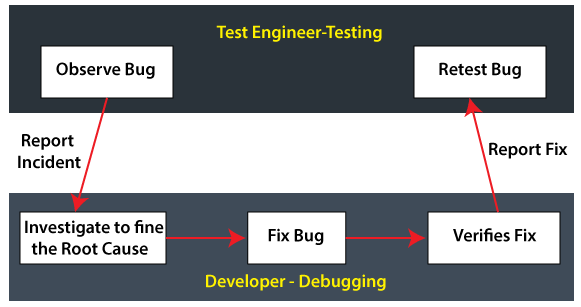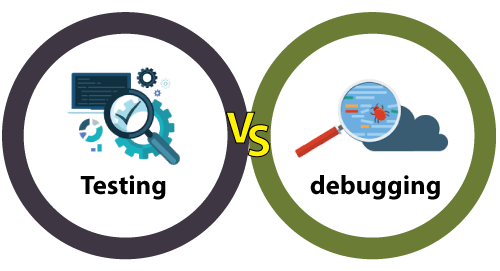In this section, we are going to understand the difference between Testing and Debugging. Both the terminologies are the integral parts of SDLC as both are used at the different phase of Software Development Life Cycle and gives distinct types of outcomes.
At the time of development and after the outcome of any application or the software product established in any programming language, both Testing and Debugging play a vital role in finding and removing mistakes.
Note: Both Testing and Debugging are two words that seem to share a similar meaning but intensively different from one another.
They have quite an equivalent function, but they are diverse in terms of designs, requirements, benefits, and performance.
Therefore, it is required for us to understand the differences between testing and debugging properly that will support us in receiving better software development outcomes.
Before we see the difference between testing and debugging, we will discuss the in-detail evaluation of testing and debugging, which will help us distinguish both of them appropriately.

What is Software Testing?
Software testing is a process of identifying defects in the software product. It is performed to validate the behavior of the software or the application compared to requirements.
In other words, we can say that the testing is a collection of techniques to determine the accuracy of the application under the predefined specification but, it cannot identify all the defects of the software.
Each software or application needs to be tested before delivering to the clients and checks whether the particular software or the application is working fine as per the given requirements.
What is Debugging?
As opposed to Testing, Debugging is the action where the development team or a developer implements after receiving the test report related to the bugs in the software from the testing team.
In the software development process, debugging includes detecting and modifying code errors in a software program.
In debugging process, the developer needs to identify the reason behind the particular bug or defect, which is carried out by analyzing the coding rigorously.
The developer changes the code and then rechecks whether the defect has been deleted whenever the bug or error is found.
Once the debugging is successfully finished, the application is again sent back to the test engineers, who remain in the process of testing.
The debugging process allows us an earlier finding of an error and makes software development stress-free and easy.
Now, based on features and technique of practice, we can distinguish between Testing and Debugging.
Testing Vs. Debugging

In the below table, we have listed some of the significant difference between testing and debugging:
|
S.NO |
Testing |
Debugging |
|
1. |
It is the
implementation of the software with the intent of identifying the defects |
The process of
fixing and resolving the defects is known as debugging. |
|
2. |
Testing can be
performed either manually or with the help of some automation tools. |
The debugging
process cannot be automated. |
|
3. |
A group of test
engineers executes testing, and sometimes it can be performed by the
developers. |
Debugging is done by
the developer or the programmer. |
|
4. |
The test engineers
perform manual and automated test cases on the application, and if they
detect any bug or error, they can report back to the development team for
fixing. |
The developers will
find, evaluates, and removes the software errors. |
|
5. |
Programming
knowledge is not required to perform the testing process. |
Without having an
understanding of the programming language, we cannot proceed with the
debugging process. |
|
6. |
Once the coding
phase is done, we proceed with the testing process. |
After the
implementation of the test case, we can start the Debugging process. |
|
7. |
Software Testing
includes two or more activities such as validation and verification of the
software. |
Debugging tries to
match indication with cause, hence leading to the error correction. |
|
8. |
It is built on
different testing levels such as Unit Testing, Integration Testing, System
Testing, etc. |
It is built on
different kinds of bugs because there is no such level of debugging is
possible. |
|
9. |
Software testing is
the presentation of defects. |
It is a logical
procedure. |
|
10. |
Software testing is
the vital phase of SDLC (Software Development Life Cycle). |
It is not a part of
SDLC because it occurs as a subset of testing. |
|
11. |
Some advantages of
software testing are as below:
|
Some advantages of
debugging process are as follows:
|
|
12. |
Software testing
contains various type of testing methods, which are as follow:
And some other type
of testing types is as below:
|
Debugging involves a
various type of approaches, which are as follows:
|
|
13. |
The testing team can
subcontract to the outside team as well. |
Debugging cannot be
subcontracted to an outside team because the inside development team only
does it. |
|
14. |
We can plan, design,
and implement the testing process. |
As compared to the
testing process, the debugging process cannot be forced. |
Conclusion
In this article, we understood that testing and
debugging are the essential parts of the software testing life
cycle, and both of them play a crucial role in detecting bugs and errors in
the software.
After seeing the critical differences between testing and
debugging, we can say that both terminologies are dependent on each other,
which means that one cannot be implemented without the other one.
The outcome of implementing the debugging process is that the
issue was fixed and available for re-testing. The test engineer does not fix
the defects; relatively, they verify those bugs, which is resolved by the
developers.
Finally, we can conclude that the developers execute the
debugging, and they fix the issues reported by the test engineers in the
debugging phase.
The testing and the debugging process are performed to make the
particular software product better and improved way.
And it doesn't depend on which team (testing and debugging team)
we belong to.



0 Comments